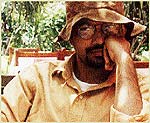|
Profile
|
||
Profile
The Business of Art
 Art
and economics. Not the most common double-degree combination,
but one that suited Oberlin freshman Kamal Quadir in 1992. He
moved through his art program successfully and bonded with his
professors, but when Quadir's final course requirement conflicted
with a Roman Polansky film class, he chose the filmmaker and
forfeited his art degree.
Art
and economics. Not the most common double-degree combination,
but one that suited Oberlin freshman Kamal Quadir in 1992. He
moved through his art program successfully and bonded with his
professors, but when Quadir's final course requirement conflicted
with a Roman Polansky film class, he chose the filmmaker and
forfeited his art degree. No
matter. Quadir '96, the corporate communications manager and
assistant to the president for Unocal Corporation in Bangladesh,
is an accomplished painter whose work appears in the Bangladesh
National Museum, the Liberation War Museum, and in private collections
worldwide. "Art on Windows," his series of nine paintings on
glass, was shown at The National Art Gallery at Shilpakala Academy,
the most prestigious art and cultural institution in Bangladesh.
The August exhibit was his second in Bangladesh and attracted
tremendous attention of the art community and national newspapers.
"The
organization of an exhibit is more involved than is apparent,"
says Quadir, who relishes his corporate business training and
its effect on his artistic success. "The process is like what
an advertising agency goes through in working for weeks to present
a product in a 20-second ad. Here I assemble a venture which
has a short and limited exposition, two weeks at most. There
are business challenges in making it financially viable, soliciting
corporate sponsors, and managing the press. Sharing one's work
is very important for an artist's growth."
Quadir's
debut exhibit in Bangladesh, a 1997 display of silk-screens
and oil paintings, did more than introduce his creative talents.
The exhibit attracted the attention of U.S.-based energy executives
in Bangladesh who lured Quadir away from his then-current job
in New York. Knowing nothing about the industry, he accepted
the offer anyway.
"Being
a Bangladeshi American, I had a deep desire to participate in
the development of Bangladesh. When an opportunity for direct
participation came, I poured myself into it," recalls Quadir,
who climbed to the top executive team within 20 months.
These
days he spends at least 60 hours-per-week at his job and another
ten in his studio. He finds the two aspects of his life to be
enormously rewarding and of great benefit to each other. "We
all have to be creative in life," he says. "Whether you're a
writer or a speaker or a businessperson, creativity is the key
to every business because it allows you to see alternatives.
Otherwise, you can't survive professionally."
"While
Quadir is one of many excellent painters who have had exhibits
in Bangladesh, his work eschews the folk art tradition, with
its scenes of South Asian rural life, from which most local
artists take inspiration," says friend and colleague Zeeshan
Hasan '93. "The absence of indigenous themes in Quadir's works
is experimental and innovative, and demonstrates that glass
painting is sure to become a new genre of art in Bangladesh."